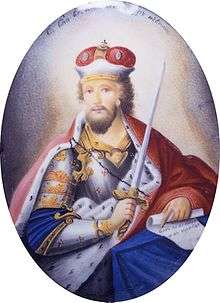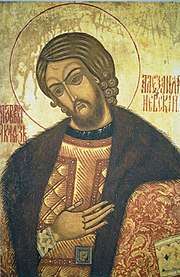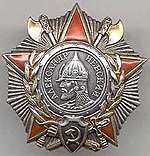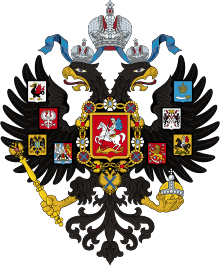Alexander Nevsky
Alexander Yaroslavich Nevsky (Russian: Алекса́ндр Яросла́вич Не́вский; pronounced [ɐlʲɪˈksandr jɪrɐˈsɫavʲɪtɕ ˈnʲɛfskʲɪj] (![]()
| Alexander Nevsky Александр Невский | |
|---|---|
 Portrait of Alexander Nevsky | |
| Prince of Novgorod | |
| Reign | 1236–1240 |
| Predecessor | Yaroslav V |
| Successor | Andrey I |
| Reign | 1241–1256 (second time) |
| Predecessor | Andrey I |
| Successor | Vasily I |
| Reign | 1258–1259 (third time) |
| Predecessor | Vasily I |
| Successor | Dmitry I |
| Grand Prince of Vladimir | |
| Reign | 1252–14 November 1263 |
| Predecessor | Andrey II |
| Successor | Yaroslav III |
| Grand Prince of Kiev | |
| Reign | 1246–1263 |
| Predecessor | Yaroslav III |
| Successor | Yaroslav IV |
| Born | 13 May 1221 Pereslavl-Zalessky, Vladimir-Suzdal |
| Died | 14 November 1263 (aged 42) Gorodets, Vladimir-Suzdal |
| Burial | |
| Spouse | Paraskeviya (Alexandra) of Polotsk Vasilisa (Vassa) |
| Issue | Vasily Alexandrovich Eudoxia Alexandrovna Dmitry Alexandrovich Andrey Alexandrovich Daniil Alexandrovich |
| House | Rurikid |
| Father | Yaroslav II of Vladimir |
| Mother | Feodosia Igorevna of Ryazan |
| Religion | Eastern Orthodoxy |
Saint Alexander Nevsky Александр Невский | |
|---|---|
 Icon of Saint Alexander Nevsky | |
| Grand Prince of Vladimir | |
| Venerated in | Eastern Orthodox Church |
| Canonized | 1547 by Metropolite Macarius |
| Major shrine | Vladimir; Pereslavl-Zalessky, Saint Petersburg |
| Feast | 23 November (Repose) 2 May (Synaxis of the Saints of Rosand Yaroslavl 30 August (Translation of relics) |
Commonly regarded as a key figure of medieval Rus', Alexander – a grandson of Vsevolod the Big Nest – rose to legendary status on account of his military victories over German and Swedish invaders. He preserved Russian statehood and Russian Orthodoxy, agreeing to pay tribute to the powerful Golden Horde. Metropolite Macarius canonized Alexander Nevsky as a saint of the Russian Orthodox Church in 1547.[2]
Childhood and youth
From Tales of the Life and Courage of the Pious and Great Prince Alexander found in the Second Pskovian Chronicle, circa 1260–1280, comes one of the first known references to the Great Prince:
"By the will of God, prince Alexander was born from the charitable, people-loving, and meek the Great Prince Yaroslav, and his mother was Theodosia. As it was told by the prophet Isaiah: 'Thus sayeth the Lord: I appoint the princes because they are sacred and I direct them.'
"... He was taller than others and his voice reached the people as a trumpet, and his face was like the face of Joseph, whom the Egyptian Pharaoh placed as next to the king after him of Egypt. His power was a part of the power of Samson and God gave him the wisdom of Solomon ... this Prince Alexander: he used to defeat but was never defeated ..."[3]
Born in Pereslavl-Zalessky, Alexander was the second son of Prince Yaroslav Vsevolodovich and Feodosia Igorevna of Ryazan. His maternal grandfather was Igor Glebovich, the second son of Gleb Rostislavich, Prince of Ryazan (d. 1178). His maternal grandmother was Agrafena of Kiev, daughter of Rostislav I of Kiev. Alexander seemed to have no chance of claiming the throne of Vladimir. In 1236, however, the Novgorodians summoned him to become knyaz (or prince) of Novgorod and, as their military leader, to defend their northwest lands from Swedish and German invaders.
According to the Novgorod Chronicle written in the 14th century (more than a century after the events it recorded), the Swedish army had landed at the confluence of the rivers Izhora and Neva, Alexander and his small army suddenly attacked the Swedes on 15 July 1240 and defeated them. Battle of the Neva saved Novgorod from a full-scale invasion from the West. Because of this battle, 19-year-old Alexander gained the sobriquet "Nevsky" (which means of Neva). This victory, coming just three years after the disastrous Mongol invasion of the Rus' lands of the North West, strengthened Alexander's political influence, but at the same time it worsened his relations with the boyars. He would soon have to leave Novgorod because of this conflict.
No non-Russian contemporary source mentions this supposed battle. The Chronicle identifies the alleged Swedish commander as "Spiridon" – while names after Saint Spyridon appear in both West and East, it is by far much more common in Orthodox lands than Scandinavia. Furthermore, Sweden had stood on the brink of war with Norway ever since the Norwegians' infamous Värmland expedition in 1225.[4] Relations improved only after the Treaty of Lödöse in 1249, which was forged by the new Swedish strongman Birger Jarl.[5] Before the treaty, Norway remained an ally of the Folkungs, giving them refuge and providing men and arms. In this situation, it seems unlikely that Sweden could have been able to organize a major expedition against Novgorod. Swedes are not known to have carried out any other military campaigns between 1222 and 1249, making the claims about their forceful appearance at the Neva with Norwegians as their allies in 1240 seem questionable.
After the Germans and Estonians invaded Pskov, the Novgorod authorities sent for Alexander. In spring of 1241 he returned from exile, gathered an army, and drove out the invaders. Alexander and his men faced the Livonian heavy cavalry led by the bishop of Dorpat (Hermann, brother of Albert of Buxhoeveden). The Rus' force met the enemy on the ice of Lake Peipus and defeated the German knights and the Estonian infantry during the Battle of the Ice on 5 April 1242.
Alexander's victory marked a significant event in the history of Russia. Foot soldiers of Novgorod had surrounded and defeated an army of knights, mounted on horseback and clad in thick armour. Nevsky's great victory against the Livonian Order apparently involved only a few knights killed rather than the hundreds claimed by the Russian chroniclers; decisive medieval and early-modern battles were won and lost by smaller margins than those seen in contemporary mass conflicts.
Politician
After the Livonian invasion, Nevsky continued to strengthen Russia's Northwest. He sent his envoys to Norway and, as a result, they signed a first peace treaty between Russia and Norway in 1251. Alexander led his army to Finland and successfully routed the Swedes, who had made another attempt to block the Baltic Sea from the Russians in 1256.[6]
.jpg)
Nevsky proved to be a cautious and far-sighted politician. He dismissed the Roman Curia’s attempts to cause war between Russia and the Golden Horde, because he understood the uselessness of such war with the Tatars at a time when they were still a powerful force. Historians seem to be unsure about Alexander's behavior when it came to his relations with Mongols. He may have thought that Catholicism presented a more tangible threat to Russian national identity than paying a tribute to the Khan, who had little interest in Slav religion and culture. It is also argued that he intentionally kept the North Slav principalities and city states as vassals to the Mongols in order to preserve his own status and counted on the befriended Horde in case someone challenged his authority (he forced the citizens of Novgorod to pay tribute). Alexander tried to strengthen his authority at the expense of the boyars and at the same time suppress any anti-Mongol uprisings in the country (Novgorod Uprising of 1259). The Orthodox Church also emphasizes tolerating present civil authority of any kind more than heterodox churches (see Romans 13), which in this case would include accepting Mongol vassalage as divine judgement.
According to one interpretation, Alexander's intentions were to protect scattered principalities of what would become Muscovy from repeated invasions by the Mongol army. He is known to have gone to the Horde himself and achieved success in exempting Russians from fighting beside the Tatar army in its wars with other peoples.
Some historians see Alexander's choice of subordination to the Golden Horde and refusal of cooperation with western countries and church as an important reaffirmation of East Slavs' Orthodox orientation (begun under Duke Vladimir of Kiev and his mother Olga).[7]
Grand Prince of Vladimir
Thanks to his friendship with Sartaq Khan, Alexander was installed as the Grand Prince of Vladimir (i.e., the supreme Russian ruler) in 1252. A decade later, Alexander died in the town of Gorodets-on-the-Volga on his way back from Sarai, the capital of the Golden Horde. Prior to his death, he took monastic vows and was given the religious name of Alexis.

From the Second Pskovian Chronicle:
"Returning from the Golden Horde, the Great Prince Alexander, reached the city of Nizhny Novgorod, and remained there for several days in good health, but when he reached the city of Gorodets he fell ill ...
Great Prince Alexander, who was always firm in his faith in God, gave up this worldly kingdom ... And then he gave up his soul to God and died in peace on 12 November [1263], on the day when the Holy Apostle Philip is remembered ...
At this burial Metropolitan Archbishop Cyril said, 'My children, you should know that the sun of the Suzdalian land has set. There will never be another prince like him in the Suzdalian land.'
And the priests and deacons and monks, the poor and the wealthy, and all the people said: 'It is our end.' "[3]
Though he died in Gorodets, Alexander was laid to rest in the city of Vladimir, in the Great Abbey at The Church of the Nativity of the Holy Mother of God.
Marriage and children
According to the Novgorod First Chronicle, Alexander married first a daughter of Bryacheslav Vasilkovich, Prince of Polatsk and Vitebsk, in 1239. Her name is not given in the chronicle. Genealogies name her as Paraskeviya or Alexandra (possibly birth and marital names respectively). They had five children:
- Vasily Alexandrovich, Prince of Novgorod (c. 1239–1271). He was betrothed to Princess Kristina of Norway in 1251. The marriage contract was broken. Kristina went on to marry Felipe of Castile, a son of Ferdinand III of Castile and Elisabeth of Hohenstaufen.
- Eudoxia Alexandrovna. Married Konstantin Rostislavich, Prince of Smolensk.
- Dmitry of Pereslavl (c. 1250–1294).
- Andrey of Gorodets (c. 1255 – 27 July 1304).
He married a second wife named Vasilisa or Vassa[8] shortly before his death. They had one son.
- Daniel of Moscow (1261 – 4 March/5 March 1303).[9]
Sainthood
Commonly regarded as a key figure of medieval Rus', Alexander – the grandson of Vsevolod the Big Nest – rose to legendary status on account of his military victories over German and Swedish invaders while agreeing to pay tribute to the powerful Golden Horde. He was canonized as a saint of the Russian Orthodox Church by Metropolite Macarius in 1547.[10]
Relics
Nevsky was buried in the Church of the Nativity of the Virgin monastery in Vladimir. Veneration began almost immediately after a miracle at his burial, when he supposedly extended his hand for the prayer of absolution.[11] The remains of the prince were uncovered in response to a vision, before the Battle of Kulikovo in the year 1380, and found to be incorrupt. The relics were then placed in a shrine in the church. He was glorified (canonized) by the Russian Orthodox Church in 1547. A new wooden reliquary was made in Moscow in 1695 and the relics placed in it in 1697. By order of Peter the Great the relics were then removed from Vladimir on 11 August 1723 and transported to Shlisselburg, arriving there on 20 September.[11] There they were kept until 1724, when they were brought to Saint Petersburg and installed in the Annunciation Church of the Alexander Nevsky Lavra on 30 August.[11] In 1753 a large silver shrine for the relics, made with 90 pounds of silver, was donated by Empress Elizabeth of Russia. With the completion of the Holy Trinity Cathedral of the Alexander Nevsky Lavra in 1790, the shrine and relics were transferred there at its consecration on 30 August, one of the saint's feast days.[11]
In May 1922, during the general confiscation of Russian Orthodox Church property, the shrine was opened.[12] The elaborate silver shrine was transferred to the Hermitage Museum, where it remains.[12] The relics were put into storage at the Museum of the History of Religion and Atheism, before being returned to the Holy Trinity Cathedral in 1989.[12] His principal feast day is 23 November. A second feast day was instituted on 30 August in commemoration of the placing of his relics in the Annunciation Church. He is also commemorated in common with other saints of Rostov and Yaroslavl on 23 May.
Legacy

Some of Alexander's policies on the Western border were continued by his grandson-in-law, Daumantas of Pskov, who was also beatified in the 16th century.
In the late 13th century, a chronicle was compiled called the Life of Alexander Nevsky (Житие Александра Невского), in which he is depicted as an ideal prince-soldier and defender of Russia.
On 21 May 1725, the empress Catherine I introduced the Imperial Order of St. Alexander Nevsky as one of the highest decorations in the land. During the Great Patriotic War, on 29 July 1942, the Soviet authorities introduced an Order of Alexander Nevsky to revive the memory of Alexander's struggle with the Germans. There was also an earlier Bulgarian Order dedicated to Saint Alexander which was founded on 25 December 1881, which ceased to exist when the People's Republic was declared on 16 September 1946.
In 1938, Sergei Eisenstein made one of his most acclaimed films, Alexander Nevsky, on Alexander's victory over the Teutonic Knights. The soundtrack for the film was written by Sergei Prokofiev, who also reworked the score into a concert cantata. Today the film is renowned for its extraordinary battle on ice sequence, which has served as inspiration for countless other films. In the picture, Nevsky used a number of Russian proverbs, tying Nevsky firmly to Russian tradition[13]
Alexander's proverbial phrase (paraphrasing Matthew 26:52), "Whoever will come to us with a sword, from a sword will perish," has become a slogan of Russian patriots. There is a long tradition of Russian naval vessels bearing Nevsky's name, such as the 19th-century propellor frigate Alexander Nevsky and a strategic ballistic missile nuclear submarine recently built for the Russian Navy.[14]
Alexander Nevsky's fame has spread beyond the borders of Russia, and numerous cathedrals and churches are dedicated to him, including the Patriarchal Cathedral in Sofia, Bulgaria; the Cathedral church in Tallinn, Estonia; the Cathedral church in Łódź, Poland.
On 24 September 2008, Alexander Nevsky was declared the main hero of Russia's history by popular vote, as reported by the Kommersant newspaper.
In December 2008, he was voted the greatest Russian in the Name of Russia television poll.[15]
See also
- Life of Alexander Nevsky (illuminated manuscript)
- Alexander Nevsky Cathedral—an incomplete listing of Eastern Orthodox cathedrals which bear his name
- Rulers of Russia family tree
References
- V.A. Kuchkin (1986). О дате рождения Александра Невского [About the Birthdate of Alexander Nevsky]. Вопросы истории [Questions of History] (in Russian) (2): 174–176. Archived from the original on 22 February 2015.
- "The Faithful Saint Prince Alexandr Nevsky" (in Russian), article read on 4.11.2010.
- Begunov, K., translator, Second Pskovian Chronicle, ("Isbornik", Moscow, 1955) pp.11–15.
- Värmland expedition by the Svenskt Militärhistoriskt Bibliotek.
- Treaty of Lödöse. Archived 19 May 2007 at the Wayback Machine
- The Chronicle of Novgorod, 1016-1471 - Google Boeken. Books.google.com. 28 November 2004. Retrieved 24 April 2014.
- Tarkiainen, Kari (2008). Sveriges Österland. Från forntiden till Gustav Vasa (in Swedish). Helsingfors: Svenska litteratursällskapet i Finland. pp. 96–97. ISBN 978-951-583-162-0.
- Н. М. Карамзин. История государства Российского. Том 4. Глава 2 Существование второй жены Александра у историков вызывает сомнения. Некоторые полагают, что Васса — монашеское имя Александры Брячиславовны. Подробнее по этому вопросу см. А. Карпов, Александр Невский (ЖЗЛ), М.: Молодая гвардия, 2010. С. 89 ISBN 978-5-235-03312-2
- "History", St. Daniel Monastery, Moscow
- "The Faithful Saint Prince Alexandr Nevsky" (in Russian), article read on 4.11.2010
- "Translation of the relics of St Alexander Nevsky". The Orthodox Church in America. Retrieved 23 April 2019.
- "Aleksandro-Nevskaya Lavra". rusmania.com. Retrieved 23 April 2019.
- Kevin McKenna. 2009. "Proverbs and the Folk Tale in the Russian Cinema: The Case of Sergei Eisenstein’s Film Classic Aleksandr Nevsky." The Proverbial «Pied Piper» A Festschrift Volume of Essays in Honor of Wolfgang Mieder on the Occasion of His Sixty-Fifth Birthday, ed. by Kevin McKenna, pp. 277-292. New York, Bern: Peter Lang.
- The US Liberty ship the S.S. Henry W. Corbett, launched in 1943 in Portland, Oregon, US was lent to the U.S.S.R. during WWII. After the war it was renamed by the Russian navy the Alexander Nevsky.
- "Stalin voted third-best Russian". BBC. 28 December 2008.
Further reading
- Isoaho, Mari. The Image of Aleksandr Nevskiy in Medieval Russia: Warrior and Saint (The Northern World; 21). Leiden: Brill Academic Publishers, 2006 (hardcover, ISBN 90-04-15101-X).
- "Tale of the Life and Courage of the Pious and Great Prince Alexander [Nevsky]" in Medieval Russia's Epics, Chronicles, and Tales, ed. Serge Zenkovsky, 224-235 (New York: Meridian, 1974)
External links
| Wikimedia Commons has media related to Alexander Nevsky. |
- Repose of Saint Alexander Nevsky Orthodox icon and synaxarion (23 November)
- Alexander Nevsky: politics under Mongol domination.
- Synaxis of the Saints of Rostov and Yaroslavl (23 May)
- Translation of the relics of Saint Alexander Nevsky (30 August)
- Saint Alexander on Nevsky Prospekt.
- Cawley, Charles, Alexander Nevsky's listing in Medieval Lands by Charles Cawley., Medieval Lands database, Foundation for Medieval Genealogy
- Kommersant: Russia’s Hero is Grand Prince Alexander Nevsky (24 September 2008)
- Interfax news agency: Orthodox believers found heaven guardians for Russian secret service (22 September 2008)
| Regnal titles | ||
|---|---|---|
| Preceded by Andrew II |
Grand Prince of Vladimir 1252–1263 |
Succeeded by Yaroslav III |

.svg.png)
.svg.png)
